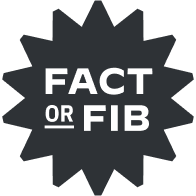Why you shouldn't flip a coin to make a decision
Wednesday, January 10, 2024
 Make every day more interesting. Each day a surprising fact opens a world of fascinating information for you to explore. Did you know that….?
Make every day more interesting. Each day a surprising fact opens a world of fascinating information for you to explore. Did you know that….? 









| | Original photo by DNY59/ iStock |
| Coin flips are not actually random. | Coin flipping is a time-honored tradition for making decisions. Long before the NFL used the method to determine opening kickoffs, Romans employed coin tossing to settle personal disputes (though they called it "heads or ships," a reference to the Roman coin's two-faced Janus on one side and the prow of a ship on the other). While the mechanics of coin flipping are simple enough — guess a side and flip — the physics of how a coin flips are anything but. By exploring this complicated motion, scientists have discovered that coin flips are not as random (and thus impartial) as most of us think.
A 2023 study from the University of Amsterdam flipped 350,757 coins across 46 different currencies and discovered that a coin flipped to its starting position 50.8% of the time — close to 50/50, but not quite. In other words, if a coin started heads up, there was a slightly greater chance it would land heads up, too. This proves a previous theorem, developed in 2004, which argued that coin tosses landed as they started about 51% of the time. This small difference likely won't dissuade humans from practicing the coin flip tradition, however. A more serious concern comes from a 2009 study, which revealed that coin tosses can be easily manipulated with just a few minutes of practice. So if you're relying on the "randomness" of a coin toss to determine important decisions, make sure you trust the person doing the flipping.
|
|
 | | The Wright brothers decided who'd fly first with a coin toss. | | |
|
|
| The Wright brothers decided who'd fly first with a coin toss. |  |  |
|
|
|
|
|
| The study of coins is known as __. |  |
|
|
 | Numbers Don't Lie |
|
 | | Year Italian Gerolamo Cardano completed "Liber de Ludo Aleae," the first treatise on probabilities | | 1564 |
|
|  | | Number of coins the U.S. Mint struck for circulation in 2022 | | 12 billion |
|
|
|
 | | Auction price of the 1933 St. Gaudens Gold Double Eagle, the most expensive U.S. coin ever minted | | $18.9 million |
|
|  | | Diameter (in mm) of the oldest U.S. coin, the Fugio, minted in 1787 | | 28 |
|
|
|
|
|
 | The U.S. was one of the first countries to have a decimal currency. |
|
| The United States has been pretty slow on the metric uptake, but when it comes to rationalizing currency, it's actually one of the leaders. Although the first (incomplete) example of decimalization occurred in Czarist Russia around 1704, the U.S. decimalized its currency with the Coinage Act of 1792, which established that 100 pennies make a dollar. This was a huge improvement, especially for the nonmathematically inclined, over the British system, wherein 1 pound equals 20 shillings, 1 shilling equals 12 pence, and 1 pence equals 4 farthings. However, this decimal system only pertained to coins at the time. Paper money didn't enter circulation until 1861, when an embattled Union government, desperate for money during the Civil War, produced the first banknotes — known as "greenbacks." | | |
|
|
|
|
|


posted by June Lesley at 5:29 AM


![]()
![]()
![]()
![]()
0 Comments:
Post a Comment
<< Home